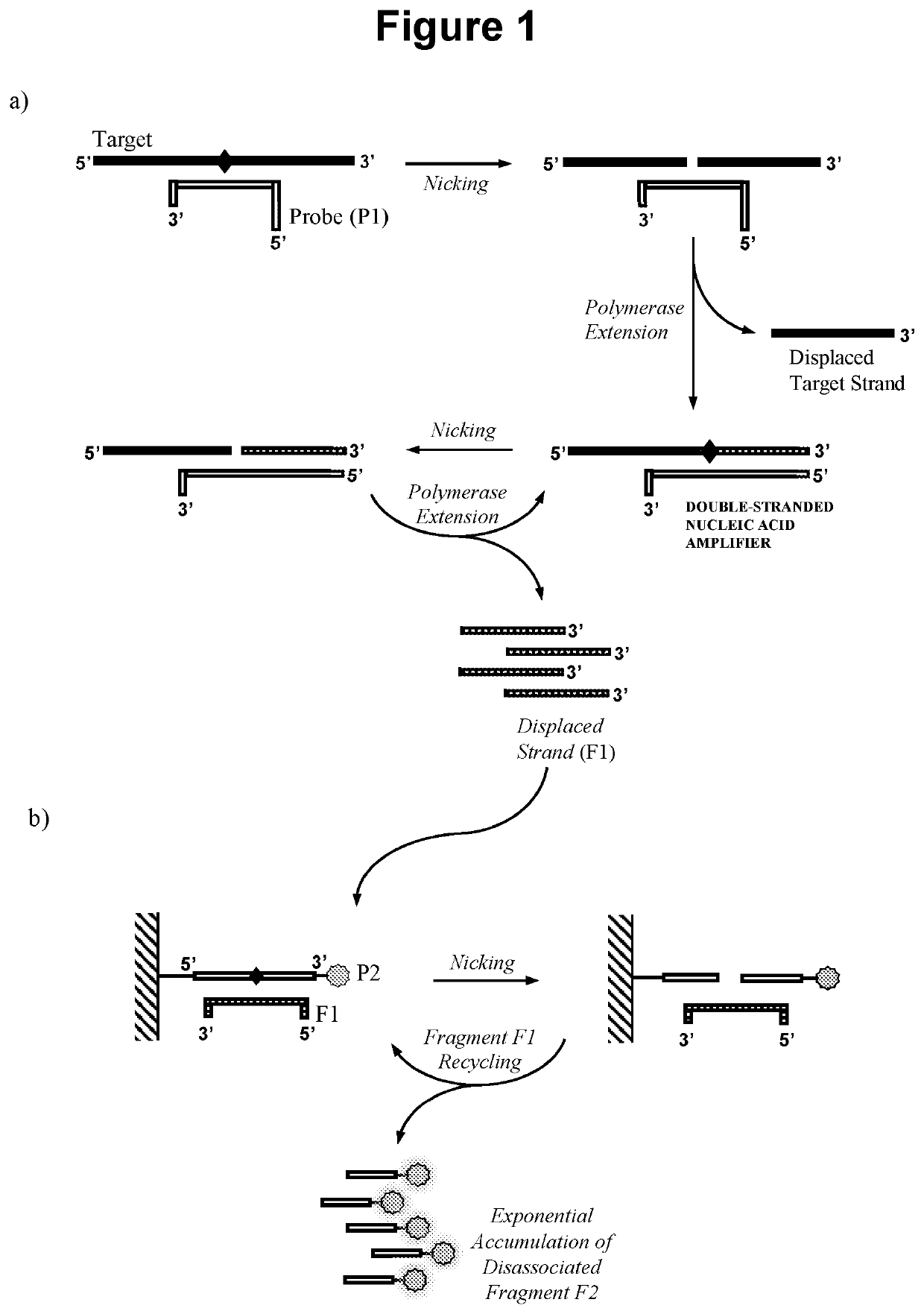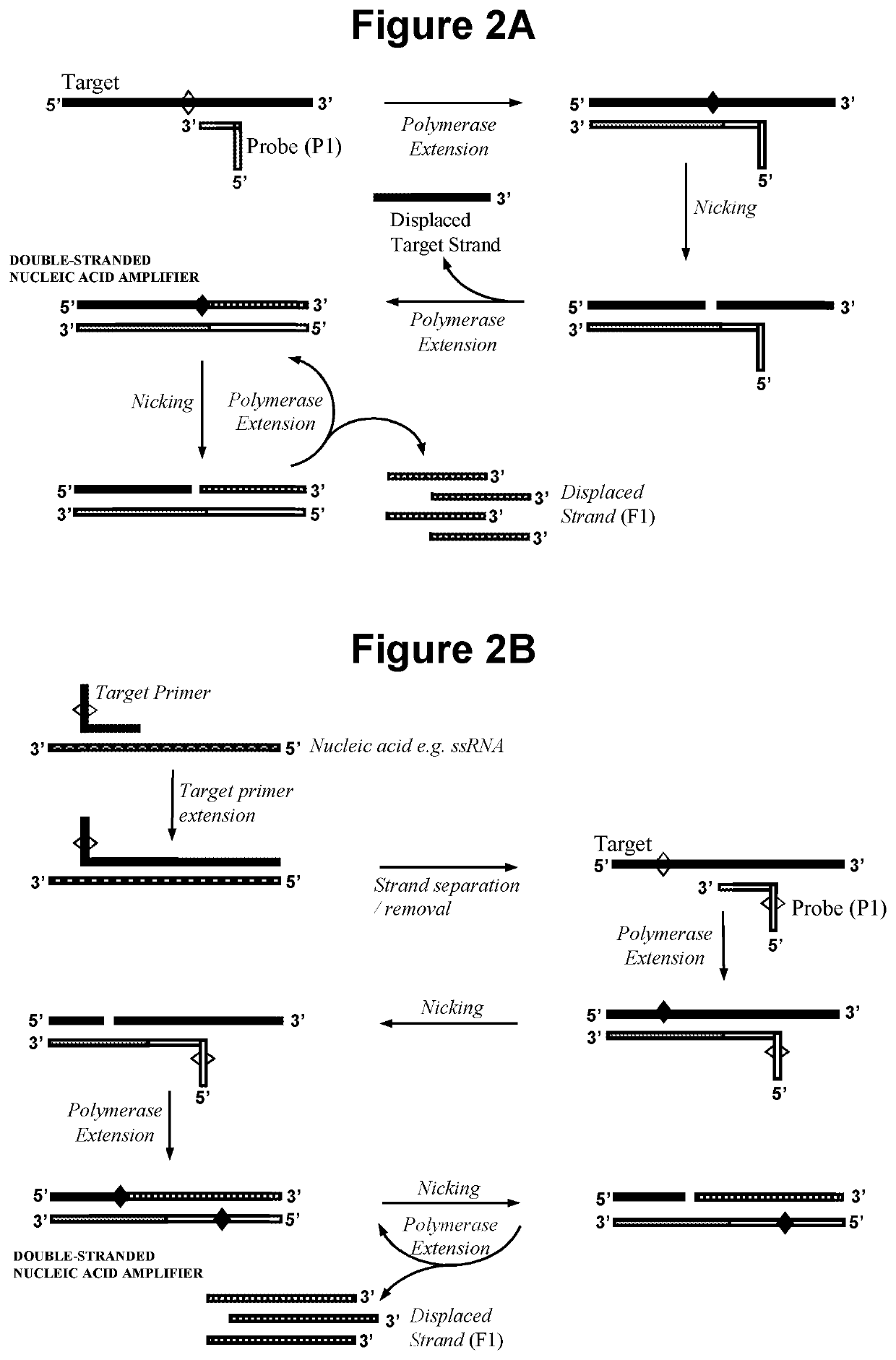Nucleic acid detection method
- Summary
- Abstract
- Description
- Claims
- Application Information
AI Technical Summary
Benefits of technology
Problems solved by technology
Method used
Image
Examples
example 1
Detection of Target Nucleic Acids Using Linear Amplification in Step a)
[0203]In this example we performed detection of a control target nucleic acid using an embodiment of the method of the invention with linear amplification in step a), i.e. with no cross-priming and with a single nicking agent cleavage site in the double-stranded nucleic acid amplifier. A synthetic DNA oligonucleotide was employed as control target and detection of probe fragments F2 produced following cleavage of probe P2 was performed using either polyacrylamide gel electrophoresis, stained with SYBR Gold, or by nucleic acid lateral flow with colorimetric detection (carbon nanoparticles).
[0204]Firstly oligonucleotide probe P1 was designed comprising in the 5′ to 3′ direction 26 nucleotide bases of single stranded DNA with the following sequence components: (i) 10 bases comprising the complementary sequence of a nicking agent recognition sequence and cleavage site present within the target nucleic acid; and (ii) ...
example 2
Detection of Target Nucleic Acids Using Exponential Amplification in Step a)
[0211]In this example we performed detection of a viral target nucleic acids using various embodiments of the method of the invention with exponential amplification in step a), i.e. P1 was designed to include cross-priming capability and with multiple nicking agent cleavage sites in the double-stranded nucleic acid amplifier.
[0212]2.1. Exponential Amplification in Step a) with No Extension of Oligonucleotide Probe P1.
[0213]In this embodiment the double-stranded nucleic acid amplifier is produced as illustrated in FIG. 1, in that oligonucleotide probe P1 does not require extension and can be capped at the 3′ end. Steps a), b) and c) of the reaction were performed sequentially and detection in step c) was performed by gel electrophoresis.
[0214]Firstly oligonucleotide probe P1 was designed comprising in the 5′ to 3′ direction 39 bases of single stranded DNA with the following sequence components: (i) 13 bases c...
example 3
Investigation of Reaction Parameters
[0240]We have explored a number of parameters of the method of the invention. These examples demonstrate the versatility of the method in terms of, for example, reaction conditions, target type and detection modality.
3.1. Performance of the Method of the Invention at Different Temperatures
[0241]Our investigations with a range of variants of oligonucleotide probe P1 and P2 have revealed that the method of the invention operates over a broad temperature range, including unusually low temperatures compared to known methods without significant loss of reaction performance, such as sensitivity or specificity.
[0242]In this example, P1 was designed as follows:
P1:5′-BBBXXXXXC*CCCCBBBXXXXXC*CCCCDDDDDDDDDDD*DDDD_D-3′TS:3′-ddddddddddd_dddd / dXXXXXd...5′
[0243]A double-stranded nucleic acid amplifier is produced of the following composition following the action of the first nicking agent and the polymerase. A single double-strand cleaving agent with recognition...
PUM
| Property | Measurement | Unit |
|---|---|---|
| Electrical resistance | aaaaa | aaaaa |
| Colorimetric evaluation | aaaaa | aaaaa |
| Electric impedance | aaaaa | aaaaa |
Abstract
Description
Claims
Application Information
 Login to View More
Login to View More - R&D
- Intellectual Property
- Life Sciences
- Materials
- Tech Scout
- Unparalleled Data Quality
- Higher Quality Content
- 60% Fewer Hallucinations
Browse by: Latest US Patents, China's latest patents, Technical Efficacy Thesaurus, Application Domain, Technology Topic, Popular Technical Reports.
© 2025 PatSnap. All rights reserved.Legal|Privacy policy|Modern Slavery Act Transparency Statement|Sitemap|About US| Contact US: help@patsnap.com



